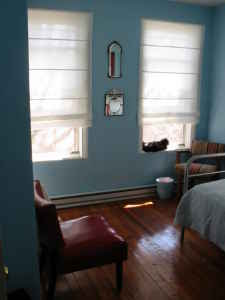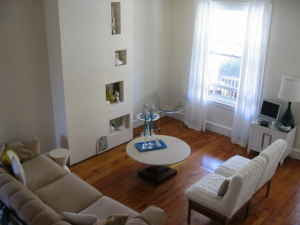




At the time the simplistic narratives and boldly graphic visual mannerisms of comics and advertising were understood to resist the powerful postwar legacy of abstract expressionist painting—the highly subjective processes and grand claims for psychic content that characterized the work of Jackson Pollock, Mark Rothko, Willem de Kooning, and other New York School artists whose achievement had recently placed American art at the center of a world stage.
 This action shot is of Juan Carlos & myself collecting samples for radiocarbon dating from the floor of a room (or patio, I can't remember). If I remember correctly, the dates we have from those buildings suggest they were built after 800 AD.
This action shot is of Juan Carlos & myself collecting samples for radiocarbon dating from the floor of a room (or patio, I can't remember). If I remember correctly, the dates we have from those buildings suggest they were built after 800 AD. We did not find any child/juvenile burials during the field seasons of 1999 & 2000. Over the course of a 2 week span in 2001 we found a bunch of child/juvenile burials like the one above. Most were found underneath the floors of rooms, most were single individuals in a flexed position, and I think most or all had pots on their heads like this little fella.
We did not find any child/juvenile burials during the field seasons of 1999 & 2000. Over the course of a 2 week span in 2001 we found a bunch of child/juvenile burials like the one above. Most were found underneath the floors of rooms, most were single individuals in a flexed position, and I think most or all had pots on their heads like this little fella.
 The picture above is of the steps down into the building, and in the center of the building was a small, stone lined cist (about 1m wide and 1m deep. The building was some sort of ritual space - we found no evidence that people cooked, processed foo, made pots, or any of the other kind of daily activities people may have done. The floor was covered in about 4=6 inches of ash, suggesting that the last thing people did in the building before it was abandoned was to burn a bunch of stuff inside it. In the back of the building, opposite of the steps, we found 22 human skulls on the floor and a few human hands (can't remember how many). Most of the skulls have small holes drilled into them that were likely used to put them on strings, and most have cut marks indicative of de-fleshing, meaning these weren't old skulls they had lying around but were taken from living people.
The picture above is of the steps down into the building, and in the center of the building was a small, stone lined cist (about 1m wide and 1m deep. The building was some sort of ritual space - we found no evidence that people cooked, processed foo, made pots, or any of the other kind of daily activities people may have done. The floor was covered in about 4=6 inches of ash, suggesting that the last thing people did in the building before it was abandoned was to burn a bunch of stuff inside it. In the back of the building, opposite of the steps, we found 22 human skulls on the floor and a few human hands (can't remember how many). Most of the skulls have small holes drilled into them that were likely used to put them on strings, and most have cut marks indicative of de-fleshing, meaning these weren't old skulls they had lying around but were taken from living people.

I found these awesome little books while rooting around at Hub’s Place in Ithaca last fall. I've scanned in parts of two of them - Patter Parade (published in 1947) and Flip Lines (published in 1952). The books have page after page of jokes, gags, and come-backs for professional comedians speakers, and magicians. I bought them thinking of Sara and her love of corny jokes but have never got around to sending them out to her. I just re-discovered them as we’re sifting through our junk for the move.
The author, Robert Orben, wrote them, and dozens of other books like them. Mr. Orben is a long-time professional comedy writer who has written for all sorts of famous comedians. These are genuine, old-school jokes and gags from a guy who must have created hundreds of thousands of jokes in his lifetime. He wrote Jack Paar’s monologues for the old Tonight Show and helped write speeches for Nixon & Ford. If you can believe it, in1963 or 1964, every day he was sending a page of jokes to Dick Gregory (social activist/comedian) – AND a page jokes to Barry Goldwater (arch-conservative). Here's a great interview with him from 2004 where he talks about his carer, writing jokes and speeches, and comedy.
I've put some of my favorite lines below, but my favorite overall is the entire routine titled "My second impression of an evening with a push button radio."
Dancer:
No Laughs:
Beautiful Girls:
Restaurant:
Hospital Daze:
Crime doesn’t pay but the hours sure are good!




| Wardrobe | Free (basement of | $60 |
| Ikea chair | Free (from Rhonda) | $45 |
| Green chair | < $15 | $35 |
| Ikea bar stools | Free (from Rhonda) | $20 |
| Corner shelf | < $50 | $60 |
| Record player | Free (from Juan Carlos) | $45 |
| Porch glider | $35 | $150 |
| Wardrobe | Free (basement of | $60 |
| Vintage linen | < $3 | $6.99 |
| Ikea sofa | $50 (sofa was free from Rhonda, cover $50) | $45 |

My blog is worth $2,258.16.
How much is your blog worth?
The aim of the thesis is to study the search for things and how it influences individuals and their relations to objects and the places in which they search.The thesis focuses on what is termed serendipitous searching – i.e. an activity of open browsing for anything that awakens the person’s interest. That means that the people in the study are not just looking for certain things – they are also seeking to come to terms with what they are actually looking for. Ideals of what is beautiful, useful and reasonable materialise in conjunction with the experience of what is available and what is absent or out of reach. It is suggested that this mode of looking for goods is not only about purchase deliberations, but more importantly is a specific way of interacting with the world and making places meaningful. It can be viewed as a way of creating and moderating anticipation, and thereby cultivating affect. Searching for things thus becomes an experiential horizon.
Part I: “Searching and Space” deals with how searching for something becomes a specific way of engaging with the physical surroundings. The landscape becomes a taskscape, i.e. an array of physical structures linked together by a set of related activities. Part II, “Discoveries and Rubbish” explores how the activities of searching charges objects with qualities. Through two different environments, searching is analysed as a way of elevating things from the status of rubbish to one of discovery. Part III: “From the Horizon of Finding” focuses on how the searchers’ aims are transformed when they encounter the objects that really exist.